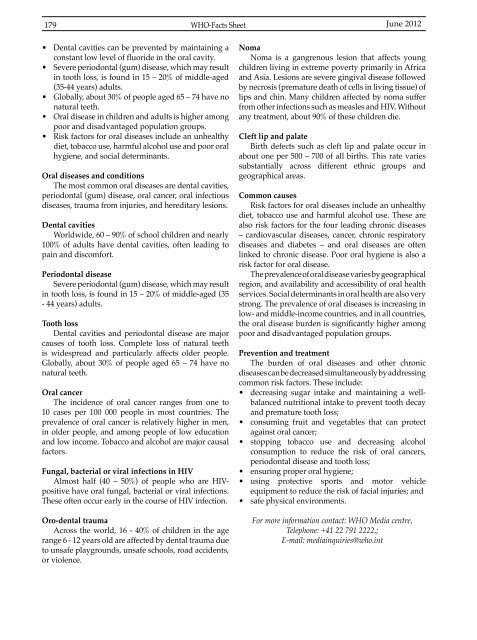Vol 44 # 2 June 2012 - Kma.org.kw
Vol 44 # 2 June 2012 - Kma.org.kw
Vol 44 # 2 June 2012 - Kma.org.kw
Create successful ePaper yourself
Turn your PDF publications into a flip-book with our unique Google optimized e-Paper software.
179<br />
WHO-Facts Sheet <strong>June</strong> <strong>2012</strong><br />
• Dental cavities can be prevented by maintaining a<br />
constant low level of fluoride in the oral cavity.<br />
• Severe periodontal (gum) disease, which may result<br />
in tooth loss, is found in 15 – 20% of middle-aged<br />
(35-<strong>44</strong> years) adults.<br />
• Globally, about 30% of people aged 65 – 74 have no<br />
natural teeth.<br />
• Oral disease in children and adults is higher among<br />
poor and disadvantaged population groups.<br />
• Risk factors for oral diseases include an unhealthy<br />
diet, tobacco use, harmful alcohol use and poor oral<br />
hygiene, and social determinants.<br />
Oral diseases and conditions<br />
The most common oral diseases are dental cavities,<br />
periodontal (gum) disease, oral cancer, oral infectious<br />
diseases, trauma from injuries, and hereditary lesions.<br />
Dental cavities<br />
Worldwide, 60 – 90% of school children and nearly<br />
100% of adults have dental cavities, often leading to<br />
pain and discomfort.<br />
Periodontal disease<br />
Severe periodontal (gum) disease, which may result<br />
in tooth loss, is found in 15 – 20% of middle-aged (35<br />
- <strong>44</strong> years) adults.<br />
Tooth loss<br />
Dental cavities and periodontal disease are major<br />
causes of tooth loss. Complete loss of natural teeth<br />
is widespread and particularly affects older people.<br />
Globally, about 30% of people aged 65 – 74 have no<br />
natural teeth.<br />
Oral cancer<br />
The incidence of oral cancer ranges from one to<br />
10 cases per 100 000 people in most countries. The<br />
prevalence of oral cancer is relatively higher in men,<br />
in older people, and among people of low education<br />
and low income. Tobacco and alcohol are major causal<br />
factors.<br />
Fungal, bacterial or viral infections in HIV<br />
Almost half (40 – 50%) of people who are HIVpositive<br />
have oral fungal, bacterial or viral infections.<br />
These often occur early in the course of HIV infection.<br />
Oro-dental trauma<br />
Across the world, 16 - 40% of children in the age<br />
range 6 - 12 years old are affected by dental trauma due<br />
to unsafe playgrounds, unsafe schools, road accidents,<br />
or violence.<br />
Noma<br />
Noma is a gangrenous lesion that affects young<br />
children living in extreme poverty primarily in Africa<br />
and Asia. Lesions are severe gingival disease followed<br />
by necrosis (premature death of cells in living tissue) of<br />
lips and chin. Many children affected by noma suffer<br />
from other infections such as measles and HIV. Without<br />
any treatment, about 90% of these children die.<br />
Cleft lip and palate<br />
Birth defects such as cleft lip and palate occur in<br />
about one per 500 – 700 of all births. This rate varies<br />
substantially across different ethnic groups and<br />
geographical areas.<br />
Common causes<br />
Risk factors for oral diseases include an unhealthy<br />
diet, tobacco use and harmful alcohol use. These are<br />
also risk factors for the four leading chronic diseases<br />
– cardiovascular diseases, cancer, chronic respiratory<br />
diseases and diabetes – and oral diseases are often<br />
linked to chronic disease. Poor oral hygiene is also a<br />
risk factor for oral disease.<br />
The prevalence of oral disease varies by geographical<br />
region, and availability and accessibility of oral health<br />
services. Social determinants in oral health are also very<br />
strong. The prevalence of oral diseases is increasing in<br />
low- and middle-income countries, and in all countries,<br />
the oral disease burden is significantly higher among<br />
poor and disadvantaged population groups.<br />
Prevention and treatment<br />
The burden of oral diseases and other chronic<br />
diseases can be decreased simultaneously by addressing<br />
common risk factors. These include:<br />
• decreasing sugar intake and maintaining a wellbalanced<br />
nutritional intake to prevent tooth decay<br />
and premature tooth loss;<br />
• consuming fruit and vegetables that can protect<br />
against oral cancer;<br />
• stopping tobacco use and decreasing alcohol<br />
consumption to reduce the risk of oral cancers,<br />
periodontal disease and tooth loss;<br />
• ensuring proper oral hygiene;<br />
• using protective sports and motor vehicle<br />
equipment to reduce the risk of facial injuries; and<br />
• safe physical environments.<br />
For more information contact: WHO Media centre,<br />
Telephone: +41 22 791 2222,;<br />
E-mail: mediainquiries@who.int
















